8 Types of Henna / Mehndi Designs to Inspire You
For centuries, mehndi – the art of body painting has been practiced in India, Africa, and Middle East. Henna is believed to bring good luck, prosperity, fortune and protect against evil! Mehndi is traditionally practiced for wedding ceremonies, during important rites of passage and in times of joyous celebration. The leaves of henna are crushed in fine powder and then water is added in it to make a thick paste and is applied in decorative designs on the skin. Once the design is complete, it is left to dry and a mixture made of sugar dissolved in lemon juice is applied every few hours to keep it moist and to enhance the colour of the mehndi. The plant of henna is 4 to 6 feet tall and can be found in Pakistan, Afghanistan, India, Morocco, Iran, Palestine, Syria and Tanzania. Archaeologists are of the view that henna was also use in Egypt. Some mummies with mehndi applied on their toes and fingers were found.
Mehndi is a custom and tradition in India that has been practiced in India from time unknown. Initially used for its healing and cooling properties, mehndi or henna as it is properly known here has become famous for its design all the way till the West where they are called henna tattoos. Today mehndi designing has become commercial on account of its part in many important occasions. In fact in an Indian Wedding ceremony the “Mehndi” day is a separate day and occasion in itself.
Since mehndi is considered lucky in our country, its application on the hands and feet of the bride is mandatory. Henna artists usually apply the most difficult and intricate designs on the brides as these look the loveliest. The traditional mehndi has been glammed up recently with the use of glitter and other things. People wear it to parties and other get together’s too. But it is the traditional henna that looks more beautiful and is cheaper too.
Original henna is of light orange or red stain. Other ingredients which contain tannins, and natural ingredients like indigo or coffee are added to the henna to make it richer in colour. Black tea makes henna a little richer brown in colour. Freshly grounded coffee will make it a very rich brown in colour. Beet juice will make it red. Indigo and black walnut hills will give henna a black stain.
Although tradition henna is mostly applied on hands and feet, teenager also apply henna on other parts of the body like neck and back to create a tattoo like design.
Popular Henna Designs:
Here are some of the oldest and most used motifs in a traditional design along with the logic behind them!
- Sahasrara is an ancient symbol which unites the soul with a divine sense of force.
- The proud peacock symbolises beauty.
- Swan symbolise success and beauty.
- Scorpion is a symbol of love and romance, its sting signifies cupid arrow while being stung produces the same effect as being in love.
- Birds serve as the messengers between heaven and earth.
- Dragonfly and butterflies symbolise change and rebirth.
- Intricate Paisley designs can represent fertility and luck.
- Flowers and petals symbolise pure happiness and joy.
- Vine and leaves henna designs represent devotion and vitality and are perfect for marriage celebration.
- Ancient eyes in mehndi designs represent the reflection of the evil eye, turning any evil wishes back onto the gazer while offering a spiritual form of protection. It is popular for weddings or any other of life’s journey, a mehndi eye is a comforting companion.
- Bud is a motif that is used widely by designers in India and all over the world. Bud signifies new growth especially at the end of a draught and beginning of the rainy season thus represents a new life, fertility and joy. It is a metaphor to symbolise the start of a new life or new love.
- The chess board is an ancient symbol in different variants, represent happiness and joyful moments.
- Lotus blossom represents the light within the soul and the awakening of the human soul. It also symbolises grace, beauty, creativity, sensuality and purity.
- Suns, moons and stars represent deep lasting love between the partners.
- Mandalas are circles and these circle symbolise the Sun. It symbolises caring, and protective of infertility, hunger and sorrows of old age and death. It is also a symbol of fertility and blessing.
Types of Mehndi Designs:
1. Rajasthani and Marwari Mehndi Design:
Rajasthani mehndi design is the most difficult design to perform and is loved the most by females all across India. These designs represent the folk culture, beauty and tradition of Rajasthan and the Marwari caste brides always prefer this design for its intricate pattern.
In Rajasthan mehndi is applied on every ocassion especially wedding. Not only the bride, but the groom also has to apply mehndi on his hand. It’s one of their customs and is followed from centuries.
Rajasthani mehndi is famous for its traditional grandeur The pattern signifies their art, rituals and customs of Marwari caste. When you look at the design you will see a unique presentation of henna, the various uses of flowers, leaves, paisley and a strong reflection of the Indian tradition. The most viewed art and the signature of these designs is the inclusion of bride and groom in almost all their design. This design represents marital happiness and unity and the fact that husband and wife now belong to each other.
Rajasthani design also follows the mirror reflecting image art. Both the hands and legs are exactly similar to one another. This is the main reason why it is a design difficult to follow.
Waves, dicing, and fans are also popular mehndi designs. The games represent prosperity and wedding bliss while the waves and fans are symbols of good fortune and good luck.
2. Pakistani Mehndi Design:
Pakistani mehndi design is one of the most popular and ranked amongst the world’s most famous mehndi designs. This mehndi design is most suitable for weddings and festivals as they cover the maximum part of hands and legs.
Pakistani mehndi design is actually very intricate and detailed. Instead of opting for large blocks of colour or geometric patterns, they are majorly composed of complex patterns of lines, symbols and pictures. This style is basically a mixture of both Indian and Arabic mehndi design. Both sharp cone and bold cone are used in this design. The outline of the design is done in Arabic style where black mehndi is applied. The inside filling is Indian which gives it its unique design. To give its unique Pakistani touch, glitters and sparkles are added.
This mehndi design is famous for bridal wears. Different styles of flowers, leaves curves are used in this design. What began as a part of Indian tradition, has involved into an art and is a symbol of their living in Pakistan.
3. Arabic Mehndi Design:
The word “Arabic” itself tells us that this design belongs to the land of Arab. The rich culture and tradition of their land is seen in their mehndi designs.
Arabic mehndi designs are very beautiful and cover the most part of hands and legs. You can use different kind of mehndi for this design like black mehndi for outline, filling with normal henna and so on. You can also use glitters to beautify the pattern. Brides in India, Pakistan and even Africa love getting this design on their hands and legs. The design does not cover the whole hand and there are a lot of gaps in between. It is this spacing apart of the design that makes this design stand out and appealing to women.
Women of any age group, young or old can apply this design. You don’t really require an occasion to apply this design. It looks good on everyone. Be it marriage, festival or any special occasion, Arabic design is the most popular among all classes of women.
4. Punjabi Mehndi Design:
Punjabis are highly populated around the world, be it Pakistan, India, England or Australia and many people are being influenced by their culture and traditions. Punjab is well known for its food, music, poetry and wedding traditions. Punjabi wedding have many rituals and ceremonies and mehndi plays a very important role in their weddings.
Punjabi mehndi design is one of the oldest designs in the nation. In henna art, the beauty of their culture and tradition are painted on the hands of both men and women. Punjabi mehndi also mark as a charm and good luck and is applied on all auspicious occasions including weddings, lohri, karwa chauth, diwali, baisakhi and so on. For this style bold mehndi design cones are used to create different design like lotus, leaves, flowers and curves.
Punjabi mehndi designs range from a very simple basic design like a red dot on the palms to the extremely complex and artistic designs. Complex designs include embroidery of spectacular work covering the palm, hands and feet of the women. Punjabi mehndi is popular for its use of dark leaves and dark red colors for both hand and legs.
5. Persian and Irani Mehndi Designs:
Persian or Irani wedding tradition goes back to the Zoroastrian tradition. Though the concept of marriage has changed over time, the tradition is more or less same as they originally were in the ancient Zoroastrian culture.
Iran is most famous for its rich carpet, the Persian gardens, mirror work, embroidery and so on .Their rich culture reflects in their mehndi designs. You can feel the complete look of Irani art and culture in their mehndi design.
This type of mehndi is done by the use of sharp cone of mehndi or henna, the lines used are fine and intricate.it uses very tiny and different types of leaves, flowers, the curve that act like the branches of trees are enhances this unique art form. Designers also make shapes of stars and moons which are quite popular in Iran. Like other mehndi designs, Irani designs don’t cover the entire hand. Persian mehndi designs are not as popular as Arabic and Pakistani designs.
6. African Mehndi Design:
In Africa, henna or mehndi is used in spiritual practice by tribes to decorate their bodies for special purpose like weddings and festivals.
The mehndi is simple, elegant and beautiful and represent their culture. Mostly simple lines and curves are used in it. Their designs mainly consist of geometric patterns, lines, dots and this design covers their hands, legs exactly like a mesh. Apart from this, the artists also use snakes and other objects in design to make it look more appealing.
7. Moroccan Mehndi Design:
Moroccan mehndi design also carries a symbolic meaning. The designs express love and concern for a person and is meant to protect a person from danger. A Moroccan warrior going for a battle gets mehndi applied to his right hand as a protective symbol and a reminder of his home life. The mehndi design motivates the soldier to return victorious and alive from the battle.
During pregnancy, Moroccon women traditionally apply mehndi as protective symbols to their ankles. This sign is supposed to ease of the delivery pain and protect the foetus. They also employ animal motif for their perceived protective powers and their ability to ward off evil.
8. Glitter Mehndi Design:
Glitter mehndi or shimmer mehndi is a very popular mehndi design which ladies apply to jazz up any occasion using coloured glitter, gem or pearls to match the colours of the outfit. Glitter mehndi designs are mostly applied on brides the day before the wedding or for other special occasion such as parties and festivals. Glitter hand mehndi looks brilliant as it stands out with its unique mehndi pattern. Glitter mehndi can be used after the normal henna is primed. Glitter mehndi acts only for a day so you can easily experiment with as much design you want to.
Mehndi is now loved worldwide and many countries have made a mark in the history of henna.
References:
http://www.stylecraze.com/articles/mehandi-designs-for-hands-to-inspire-you/

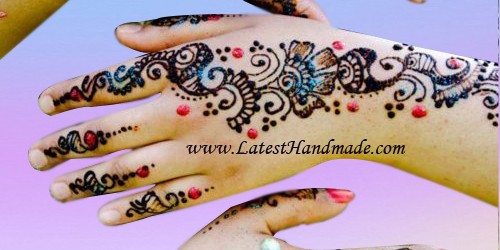
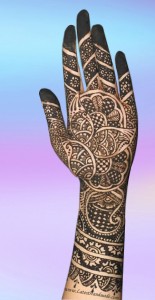
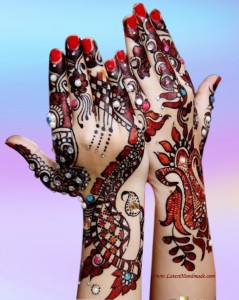
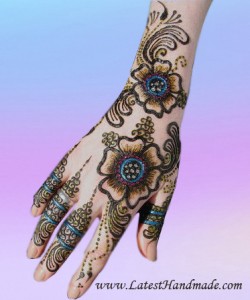
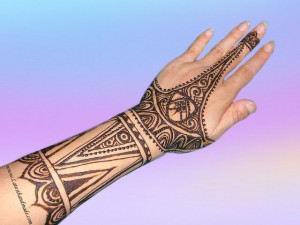
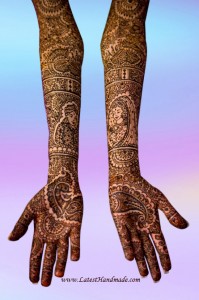
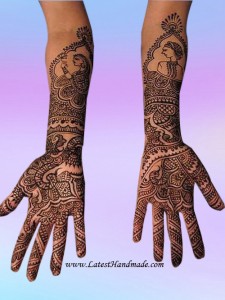
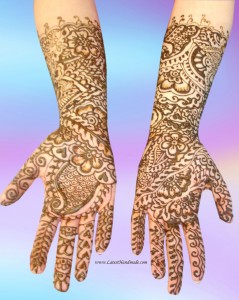
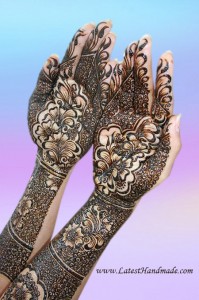
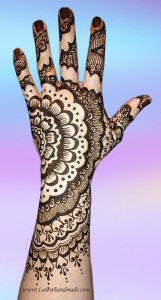
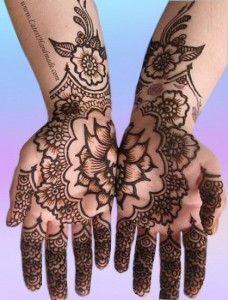
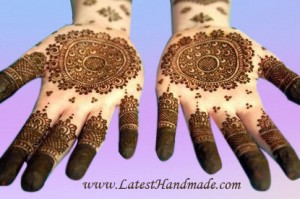
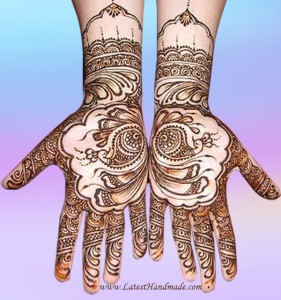
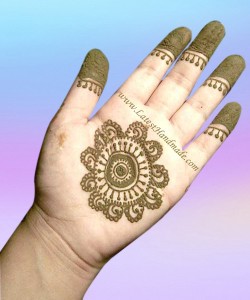
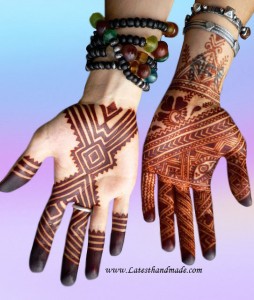
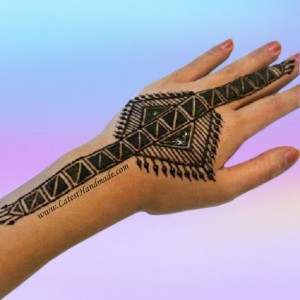
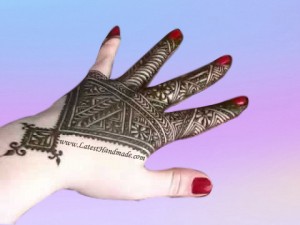
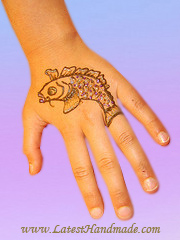
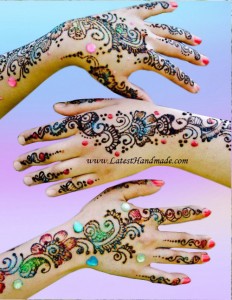













Comments are closed.